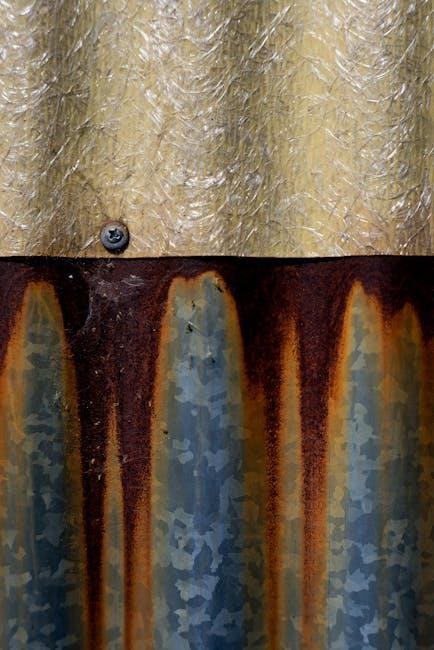A sheet metal screw size chart is an essential tool for ensuring precise fastening in various projects, from construction to DIY repairs. It provides detailed measurements, including diameters, lengths, and thread types, helping users select the right screw for their material. Whether working with metal, wood, or plastic, this guide offers clarity and confidence, preventing common issues like distortion or weak joints. Explore how this chart simplifies your projects and enhances durability.

Understanding Screw Sizes
Understanding screw sizes is fundamental for selecting the right fastener for your project. Screw sizes are typically denoted by a number (e.g., 6, 8, 10) or a diameter measurement (e.g., 1/4″, 5/16″), and they vary based on the material and application. For sheet metal screws, sizes are standardized to ensure compatibility and performance across different materials like metal, wood, or plastic.
In the imperial system, screw sizes are numbered (e.g., 2, 3, 4), with smaller numbers indicating smaller diameters. For example, a #6 screw has a smaller diameter than a #10 screw. Metric screws, on the other hand, are measured in millimeters (e.g., 4mm, 6mm). Both systems are widely used, and understanding the differences is crucial for international projects or when working with imported materials.
The screw size includes the major diameter (the largest diameter of the screw thread) and the pitch (the distance between threads). For instance, a 1/4″-20 screw has a 1/4″ diameter and 20 threads per inch. Coarse-thread screws (e.g., 1/4″-20) are commonly used for wood, while fine-thread screws (e.g., 1/4″-28) are better suited for metal. Self-tapping screws, often used in sheet metal, have specialized threads designed to create their own holes without pre-drilling.
Sheet metal screws are categorized by their head style (e.g., flat, oval, pan, or hex) and their tip type (e.g., sharp, blunt, or self-tapping). The size chart provides detailed measurements for each type, ensuring proper fitment and functionality. For example, a #8 screw with a sharp point is ideal for thin metal sheets, while a #12 screw with a blunt tip may be better for thicker materials.
Understanding screw sizes also involves recognizing the relationship between the screw and the material it is fastening. A screw that is too small may not hold securely, while one that is too large can split the material or create unnecessary stress points. Referencing a screw size chart helps eliminate guesswork and ensures the screw is appropriately matched to the task at hand.

How to Choose the Right Screw
Selecting the right screw for your project involves considering several factors, including the material you are working with, the thickness of the sheet metal, and the intended application. Sheet metal screws come in various sizes, thread types, and head styles, making it essential to match the screw to the specific requirements of your task.
First, determine the material you are fastening. Sheet metal screws are designed for use with metal, but they can also be used with wood, plastic, and other materials. The type of material will influence the screw’s diameter, length, and thread pattern. For example, screws for metal typically have finer threads than those for wood, ensuring better grip and durability.
Next, consider the thickness of the material. The screw length should be sufficient to penetrate the material fully but not so long that it protrudes excessively on the other side. A general rule of thumb is to use a screw that is at least twice the thickness of the material being fastened. For thin sheet metal, shorter screws with sharp points are ideal, while thicker materials may require longer screws with coarse threads.
Thread type is another critical factor. Coarse-thread screws are better for softer materials like wood, while fine-thread screws are more suitable for metal. Self-tapping screws, which create their own threads, are a popular choice for sheet metal applications. They eliminate the need for pre-drilling and provide a secure hold in thinner materials.
The head style and drive type should also be considered. Flat-head screws are ideal for flush surfaces, while pan-head or oval-head screws provide a slightly raised profile. Drive types, such as Phillips, slotted, or hex, determine the tool needed for installation and can affect the torque applied during driving.
Finally, consult a sheet metal screw size chart to ensure you are using the correct screw for your application. These charts provide detailed information on screw diameters, lengths, and thread patterns, helping you avoid common mistakes like using a screw that is too small or too large for the material. By carefully evaluating these factors, you can select the right screw for a secure and professional-looking finish.
Pilot Holes
Pilot holes are a critical step in ensuring successful screw installation, especially when working with sheet metal. A properly sized pilot hole helps guide the screw, prevents metal distortion, and avoids splitting or tearing the material. The size of the pilot hole depends on the screw being used, and a sheet metal screw size chart provides the necessary guidance to drill accurately.
The primary purpose of a pilot hole is to create a precise starting point for the screw. Without it, even sharp-pointed screws can wander or distort the metal as they are driven in. This is particularly important for thinner sheet metal, where the material is more prone to damage. A pilot hole ensures the screw enters straight and maintains its intended path.
To determine the correct pilot hole size, refer to the sheet metal screw size chart. This chart typically lists the recommended drill bit size for each screw diameter. For example, a #8 screw might require a 5/32″ pilot hole, while a #10 screw might need a 3/16″ hole. Using the wrong drill bit size can lead to issues such as loose fits, stripped threads, or even screw breakage.
When drilling pilot holes, it’s important to use a sharp drill bit to prevent tearing the metal. Dull bits can cause the metal to fray or bend, especially at the edges. Additionally, apply steady, consistent pressure to avoid slipping and ensure the hole is drilled in the correct location. For thicker materials or harder metals, consider using a smaller pilot hole and gradually enlarging it if needed.
In some cases, self-tapping screws eliminate the need for a pilot hole, as they create their own threads during installation. However, even with self-tappers, a small starter hole can improve accuracy and reduce the risk of metal distortion. Always consult the sheet metal screw size chart to confirm whether a pilot hole is necessary for your specific screw type and material thickness.

Material-Specific Recommendations
Choosing the right screw for your project depends heavily on the material you are working with. A sheet metal screw size chart provides valuable insights into selecting the appropriate screw type and size for various materials, ensuring optimal performance and durability. Below are some material-specific recommendations to guide your selection.
Metal: When working with metal, it’s crucial to consider the thickness and type of metal. Thinner sheets may require smaller screws with finer threads to prevent distortion, while thicker metals can accommodate larger, coarser-thread screws. For example, a #8 or #10 screw is often suitable for most metal applications, but stainless steel or aluminum may require specialized coatings to resist corrosion.
Wood: For wood, the screw’s length and thread type are critical. Coarse-thread screws are ideal for wood as they provide better grip and reduce the risk of splitting. A #8 or #10 screw with a sharp point is recommended for most woodworking projects. However, if you’re combining wood with metal, ensure the screw is long enough to penetrate both materials securely.
Drywall: Drywall requires screws with coarse threads and a bugle head to prevent tearing and provide a flush finish. Fine-thread screws are not recommended as they may pull through the drywall. A #6 or #8 screw is typically used for drywall installations, with lengths varying based on the thickness of the material.
Plastic: Plastic materials are more delicate and require screws with a smaller diameter and finer threads to avoid cracking or breaking the material. Self-tapping screws are often preferred for plastic as they create their own threads without needing a pilot hole. A #4 or #6 screw is usually sufficient for most plastic applications.
By following these material-specific recommendations and referring to a sheet metal screw size chart, you can ensure your screws are properly matched to the materials you’re working with, resulting in stronger, more durable connections; Always consider factors like thread type, screw length, and head style to achieve the best results for your project.
Detailed Size Chart
A sheet metal screw size chart is a comprehensive guide that outlines the dimensions and specifications of various screws, ensuring precise selection for your projects. Below is a detailed breakdown of screw sizes, diameters, and lengths to help you make informed decisions.
| Screw Size | Nominal Diameter (in) | Thread Diameter (in) | Length (in) |
|---|---|---|---|
| #6 | 0.138 | 0.106 | 0.25–3.0 |
| #8 | 0.164 | 0.130 | 0.25–3.0 |
| #10 | 0.190 | 0.148 | 0.25–3.0 |
| #12 | 0.216 | 0.177 | 0.25–3.0 |
| #14 | 0.242 | 0.203 | 0.25–3.0 |
The chart also includes metric equivalents for international applications. For example, a #8 screw corresponds to approximately 4.17 mm in diameter, while a #10 screw is roughly 4.87 mm. This dual measurement system ensures versatility for global projects.
Thread specifications are another critical aspect of the chart. For instance, a #8 screw typically has 16 threads per inch (TPI), while a #10 screw has 12 TPI. This detail is essential for ensuring compatibility with the material being fastened.
Lengths are categorized to suit various applications, from short screws for thin materials to longer screws for thicker or layered substrates. The chart also highlights recommended pilot hole sizes to prevent material distortion during installation.
For added convenience, the chart includes a conversion table for drill bit sizes, making it easier to prepare precise pilot holes. Whether you’re working with metal, wood, or plastic, this guide ensures you have the exact measurements needed for a secure and professional finish.
Download a printable sheet metal screw size chart PDF to keep this information handy for your next project. With its detailed specifications and clear formatting, it’s an indispensable resource for any workshop or job site.

Applications and Projects
Sheet metal screws are versatile fasteners used in a wide range of applications, from industrial manufacturing to DIY home repairs. Their ability to securely fasten metal sheets to various materials makes them indispensable in numerous projects. Whether you’re working on construction, automotive repairs, or crafting custom metalwork, understanding the right screw size and type is crucial for a successful outcome.
One of the most common applications is in construction and metal roofing, where sheet metal screws are used to secure roofing panels and siding. They are also widely used in automotive repairs for attaching body panels, trim, and accessories. In metalworking projects, these screws are essential for assembling frames, enclosures, and machinery components.
For DIY enthusiasts, sheet metal screws are a go-to for projects like building shelving, repairing appliances, or creating custom decorative items. They are particularly useful when working with thin metal sheets, as they provide a strong hold without causing excessive distortion. Additionally, these screws are ideal for furniture making, especially when combining metal frames with wood or plastic components.
In industrial settings, sheet metal screws are used for assembling conveyor systems, storage tanks, and other large-scale equipment. Their durability and resistance to corrosion make them suitable for both indoor and outdoor applications. For electrical installations, they are often used to mount panels, boxes, and wiring systems.
When selecting screws for your project, consult a sheet metal screw size chart to ensure you choose the correct diameter, length, and thread type. For example, thinner metal sheets may require finer threads and smaller diameters, while thicker materials need coarser threads and longer screws for maximum stability. This attention to detail ensures a secure and lasting connection, regardless of the project’s complexity.
By understanding the applications and selecting the right screws, you can achieve professional-grade results in your projects. Whether you’re a seasoned professional or a hobbyist, sheet metal screws are a reliable choice for any task involving metal fastening.

Installation Tips
Proper installation of sheet metal screws is crucial for ensuring a secure and durable connection. Whether you’re working on a DIY project or a large-scale industrial application, following the right techniques can make a significant difference in the outcome. Here are some essential tips to guide you through the installation process:
- Use the Correct Screw Size: Always refer to a sheet metal screw size chart to select the appropriate screw for your material thickness and type. Using a screw that is too small or too large can lead to poor retention or material damage.
- Drill Pilot Holes: To avoid distorting the metal, drill pilot holes before screw installation; The size of the pilot hole should match the screw’s minor diameter, as specified in the chart. This ensures smooth insertion and prevents the metal from buckling.
- Choose the Right Drill Bit: Use a sharp, high-quality drill bit to create clean, precise holes. Dull bits can tear the metal, leading to uneven surfaces and weakened joints.
- Align Screws Properly: Ensure the screw is aligned straight with the pilot hole to avoid cross-threading or stripping the screw head. This is especially important when working with thin metal sheets.
- Use the Correct Driver: Select a screwdriver or power tool that matches the screw head type (e.g., Phillips, hex, or square drive). Using the wrong driver can damage the screw head, making it difficult to tighten or remove.
- Apply Even Pressure: When driving the screw, apply steady, consistent pressure to prevent the screw from slipping or the metal from deforming. Avoid overtightening, as this can strip the threads or damage the surrounding material.
- Consider Material Thickness: For thicker materials, use screws with coarse threads and longer lengths to ensure adequate grip. For thinner materials, finer threads and shorter lengths are typically more suitable.
- Inspect Before Final Tightening: After inserting the screw, check its alignment and seating before applying final torque. This step helps prevent mistakes and ensures a professional finish.
By following these installation tips and referencing a sheet metal screw size chart, you can achieve a strong, reliable fastening system. Proper technique not only enhances the durability of your project but also saves time and reduces the risk of costly repairs.

Comparison with Other Screws
Sheet metal screws are often compared to other types of screws due to their unique design and application-specific features. Understanding the differences between sheet metal screws and other fasteners can help you make informed decisions for your projects. Below is a comparison of sheet metal screws with other common screw types:
Wood Screws vs. Sheet Metal Screws
Wood screws are designed for gripping wood and other soft materials, featuring coarse threads and sharp points. In contrast, sheet metal screws have finer threads and are specifically designed to fasten metal sheets to various materials. While wood screws can be used in some metal applications, they lack the precision and durability of sheet metal screws in such contexts.
Machine Screws vs. Sheet Metal Screws
Machine screws are general-purpose fasteners used in pre-tapped holes or with nuts. They are not designed for tapping their own threads, unlike sheet metal screws, which can create threads in untapped metal. This makes sheet metal screws more versatile for applications where pre-drilling and tapping are not feasible.
Self-Tapping Screws vs. Sheet Metal Screws
Self-tapping screws are similar to sheet metal screws in that they can create their own threads. However, sheet metal screws are specifically optimized for thin metal sheets, offering better grip and reduced risk of material distortion. Self-tapping screws are more commonly used in plastics and thicker materials.
Drywall Screws vs. Sheet Metal Screws
Drywall screws are designed for gypsum board and plaster, featuring a bugle head for countersinking. Sheet metal screws, with their flat or pan heads, are better suited for flush surfaces and metal-to-metal applications. Drywall screws are not ideal for metal sheets due to their coarse threads and lack of compatibility with metal materials.
Troubleshooting Common Issues
Working with sheet metal screws can sometimes present challenges, especially for those new to metal fastening projects. Common issues often arise from improper screw selection, incorrect installation techniques, or material incompatibility. Addressing these problems effectively ensures a secure and durable connection. Below are some of the most frequent issues encountered and their solutions:
Stripped Threads
Stripped threads are a common issue when screws are over-tightened or used in materials that are too hard. To prevent this, always use the correct screw size and type for your material. Refer to a sheet metal screw size chart to ensure compatibility. If threads are stripped, consider using a screw with a slightly larger diameter or switching to a self-tapping screw designed for your material.
Pilot Hole Issues
Drilling an oversized pilot hole can lead to a loose fit, while an undersized hole can cause the screw to bind or distort the metal. Always use the recommended pilot hole size from the sheet metal screw size chart. For thin metals, a smaller pilot hole may be necessary to avoid tearing the material.
Screw Head Damage
Damaged screw heads can occur if the wrong screwdriver or bit is used. Ensure you use the correct drive type (e.g., Phillips, hex, or square) for your screws. Applying excessive force can also strip the head, so tighten screws firmly but avoid over-tightening.
Material Incompatibility
Using screws in materials they are not designed for can lead to poor performance or failure. For example, screws designed for metal may not perform well in wood or plastic. Always match the screw type to your material, as indicated in the sheet metal screw size chart.
Corrosion and Rust
Corrosion can weaken the screw and material bond over time. To prevent this, use screws made from corrosion-resistant materials like stainless steel or zinc-coated steel, especially in outdoor or high-moisture environments.
By addressing these common issues and following the guidelines provided in a sheet metal screw size chart, you can ensure successful and long-lasting fastening results. Proper screw selection, accurate installation, and material compatibility are key to avoiding problems and achieving professional-grade outcomes.
Resources and Further Reading
For those seeking a deeper understanding of sheet metal screws and their applications, there are numerous resources available to provide additional guidance. These resources range from detailed technical documents to practical guides, ensuring that professionals and DIY enthusiasts alike can find the information they need. Below are some key resources to explore:
A comprehensive sheet metal screw size chart PDF is an excellent starting point. This document, often available from hardware suppliers like Bolt Depot, provides precise measurements, including screw diameters, lengths, and thread types. It also includes conversion charts for imperial and metric sizes, making it a versatile tool for international projects.
Technical standards such as ANSI B18.6.4 and ASTM F593 offer detailed specifications for sheet metal screws, including thread dimensions and material requirements. These documents are particularly useful for engineers and manufacturers working on large-scale projects. Additionally, design guides like AAMA TIR-A9-14 focus on fasteners for metal cladding, providing insights into selecting the right screws for architectural applications.
Online forums and communities, such as those dedicated to metalworking or DIY projects, are invaluable for troubleshooting and sharing experiences. Websites like Practical Machinist often feature discussions on screw selection and installation tips, offering real-world advice from experienced professionals.
Reputable hardware suppliers like McMaster-Carr and Grainger provide extensive catalogs and technical data sheets for sheet metal screws. These resources often include size charts, material specifications, and application recommendations, making them indispensable for project planning.
For those looking to print or share information, a printable sheet metal screw size chart is a handy reference. These charts are available in both imperial and metric units, ensuring compatibility with various projects and regions. They can be laminated or posted in workshops for quick access.
Exploring these resources will equip you with the knowledge to make informed decisions about screw selection, installation, and troubleshooting. Whether you’re working on a small DIY project or a large industrial application, these guides and charts are essential tools for achieving professional results.
In conclusion, understanding and utilizing a sheet metal screw size chart is crucial for ensuring the success of any project involving metal fastening. Whether you’re a professional contractor, an engineer, or a DIY enthusiast, having access to this resource empowers you to make informed decisions about screw selection, installation, and troubleshooting. The detailed measurements, including diameters, lengths, and thread types, provide the precision needed to avoid common issues like material distortion or weak joints.
The importance of a sheet metal screw size chart PDF lies in its ability to simplify complex specifications. By referencing this chart, you can quickly identify the appropriate screw for your material thickness and type, ensuring durability and safety. For instance, knowing the difference between coarse and fine threads or understanding the role of pilot holes can significantly impact the longevity of your project. This guide also serves as a valuable teaching tool, helping newcomers to the field grasp the fundamentals of fastening.
Moreover, the availability of resources like ANSI B18.6.4 and ASTM F593 standards, along with practical guides from reputable suppliers, ensures that you have access to authoritative information. These documents, often available in PDF formats, provide a comprehensive understanding of screw dimensions, materials, and applications. They are indispensable for projects requiring high precision and compliance with industry standards.

